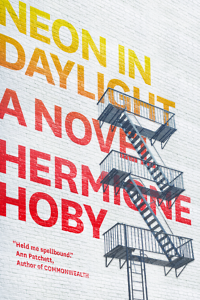Hot Time in the City
Hermione Hoby’s Neon in Daylight is set during an endless NYC heat wave
When Kate—the young British protagonist of Hermione Hoby’s debut novel, Neon in Daylight—arrives in Manhattan, disorientation rules everything she does, perhaps even everything she sees: “Impossible to remember what she thought it would be, what she’d imagined it looking like, now that she was here.” A sense that all expectations may suddenly prove meaningless—that the seasons of life may shift without warning, in fact may have shifted already—permeates this novel.

Without a job or any clear ambition for her future, Kate has seized upon a cat-sitting opportunity as a pretext for escaping her life back home, including her lovesick university boyfriend, whose texts and Skype chats only increase her desire to flee. Having set up camp in the fresh context of this alien, intimidating city, she finds herself with a free apartment and time on her hands.
Even so, an undefined sense of purpose seems to be working within her, moving her toward something outside herself. In that state of expectant readiness, she falls under the glittering lure of a father and daughter—a famous middle-aged novelist named Bill and his freewheeling, danger-seeking daughter Inez.
A new high-school graduate, Inez has entered a period of experimentation designed to answer one question: exactly how indestructible will she prove to be? Startlingly beautiful, possessing an “anarchistic spirit,” and at home as a lifelong Manhattanite surrounded by tourists and transplants, Inez takes bold strides into risky territory. She turns her barista job into a performance of open belligerence, creating a viral swell of Yelp reviewers showing up to be insulted in person. She sells Adderall to NYU students rather than applying for college herself. Soon she begins to answer Craigslist ads, fulfilling strangers’ sexual fantasies for pay.
Bill has his own long history of trouble, making his fears for his daughter feel both hypocritical and highly justified. Bill’s renown as a writer stems from the legacy of one early novel. More accurately, it stems from the film adaptation of that novel, whose star died of an overdose just in time to launch the film (and Bill’s novel) toward enormous success. Uncomfortable with this kind of fame, Bill has struggled to write and teach, succumbing to alcohol and a powerful nostalgia for the New York of his own past, “when the neighborhood had been a lovely scabrous wasteland of lawlessness and postapocalyptic potential, when being an artist and a scavenger and an addict were all the same thing. With inevitable sadomasochism, his mind formed a phrase: ‘A quarter century ago.’ He repeated it slowly, like fingers tightening around a fist.”
 Hoby imbues each of her characters with an eagle eye for their surroundings. In particular, she excels at showing how they might at any time become enveloped, even subsumed, by their city’s landscape. Here’s Kate embracing the inescapable mugginess of the summer’s heat wave: “You still couldn’t air-condition New York City streets. You could build taller towers, shinier and sharper, but the heat would always stay unassailable. It turned the air yellow with the stinking of sweltering garbage, it melted candy bars in their wrappers into formless goo, and it made all the heavy waiting bodies on subway platforms drip with sweat.”
Hoby imbues each of her characters with an eagle eye for their surroundings. In particular, she excels at showing how they might at any time become enveloped, even subsumed, by their city’s landscape. Here’s Kate embracing the inescapable mugginess of the summer’s heat wave: “You still couldn’t air-condition New York City streets. You could build taller towers, shinier and sharper, but the heat would always stay unassailable. It turned the air yellow with the stinking of sweltering garbage, it melted candy bars in their wrappers into formless goo, and it made all the heavy waiting bodies on subway platforms drip with sweat.”
Still, despite the city’s hold over them, Hoby’s three protagonists never lose their defining sense of isolation. In fact, the novel’s opening chapters focus so much on this closely observed urban loneliness that it threatens to stifle and chafe the reader. Soon enough, though, Kate, Bill, and Inez begin to interact with one another—sometimes observing their vulnerabilities and insecurities, other times propelling one another toward surprising encounters. In those scenes, Neon in Daylight finds its lifeblood and momentum, turning this novel into a fascinating, satisfying debut.

Emily Choate holds an M.F.A. from Sarah Lawrence College. Her fiction has been published in Shenandoah, The Florida Review, Tupelo Quarterly, and The Double Dealer, and her nonfiction has appeared in Yemassee, Late Night Library, and elsewhere. She lives in Nashville, where she’s working on a novel.


